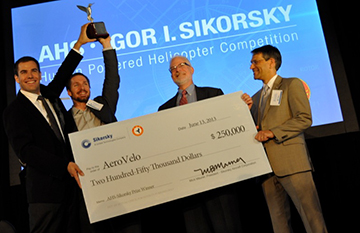
An aerospace team led by Todd Reichert, (EngSci 0T5, UTIAS PhD 1T1), and Cameron Robertson (EngSci 0T8, UTIAS MASc 0T9) won the $250,000 AHS Igor I. Sikorsky Human-Powered Helicopter Prize for the first-ever sustained flight of a human-powered helicopter. View their creation in action on Vimeo.
The American Helicopter Association, which established the Prize in 1980, has confirmed that AeroVelo Inc., founded by Reichert and Robertson, successfully met the prize’s rigorous conditions: a flight duration of 60 seconds and reaching an altitude of 3 meters while remaining in a 10-meter square.
The prize was awarded July 11 at the Ontario Soccer Centre in Vaughan, where AeroVelo made the historic flight a month before. While accepting the prize, Reichert and Robertson thanked U of T for its support, singling out U of T President David Naylor and Applied Science & Engineering Dean Cristina Amon, who were in attendance.
Many teams have vied for this prize since it was announced in 1980. History was finally made on June 13 when AeroVelo’s Atlas helicopter rose to an altitude of roughly 3.3 metres, maintained flight for approximately 65 seconds and drifted no more than 10 metres. Reichert, who holds a land speed record for cycling, was the pilot for the record-breaking feat.
Reichert and Robertson both graduated from the Engineering Science program and then completed graduate studies at the Institute for Aerospace Studies (UTIAS), where they founded U of T’s Human-Powered Vehicle Design Team. (Read more about the design team.) In August 2010, the team’s first project – a human-powered ornithopter called Snowbird – made aviation history by achieving the age-old dream of human-powered bird-like flight. “Snowbird” sustained both altitude and airspeed for 19.3 seconds, and covered a distance of 145 metres at an average speed of 25.6 kilometres per hour.
Dozens of U of T Engineering students have worked with AeroVelo on the Atlas project over the past few years, in roles ranging from repairing the vehicle after crashes to designing and testing components to actually flying the craft. All the students – members of U of T’s Human-Powered Vehicle Design Team – said that working with AeroVelo was a once-in-a-lifetime experience.
“Working with AeroVelo is the best job that I have had,” said Sherry Shi (EngSci 1T5), who helped repair Atlas after a previous crash and was the team’s photographer/videographer. “When I heard the horn signaling the three-meter altitude, I was extremely nervous and anxious because the last two flight attempts failed around this point in the flight. As I watched it descend, I could feel the excitement building up. When it landed safely, it was one of the happiest moments in my life.”
Calvin Moes (EngSci 1T3 + PEY) was responsible for design and construction of some of the craft’s components. He also actually got to fly Atlas, performing most of the low-altitude test flights. He said that working with AeroVelo was challenging but enjoyable. “I always felt that my contributions were every bit as critical to the project as anyone else’s, and I never got the impression that I was just another set of hands.”
The historic event received extensive coverage both locally and around the world. Stories have appeared in Engadget, The Guardian, the New York Times, Popular Mechanics, the Toronto Star, CBC and numerous other outlets and is also attracting attention on Twitter, Facebook and YouTube.
